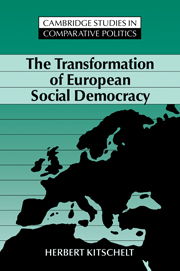Book contents
- Frontmatter
- Contents
- List of tables and figures
- Preface
- Glossary of political parties by country
- Introduction
- 1 Social structure and collective preference formation: Opportunities for left party strategy in the 1970s and 1980s
- 2 Class structure and left party performance
- 3 Political economy and left party fortunes
- 4 Social democratic strategy and electoral competition
- 5 Internal politics in socialist parties: Preference formation, aggregation, and strategic choice
- 6 The socialist discourse: Political semantics and party strategy
- 7 Social democracy in decline? Analytical and normative extensions of the argument
- References
- Index
Introduction
Published online by Cambridge University Press: 08 January 2010
- Frontmatter
- Contents
- List of tables and figures
- Preface
- Glossary of political parties by country
- Introduction
- 1 Social structure and collective preference formation: Opportunities for left party strategy in the 1970s and 1980s
- 2 Class structure and left party performance
- 3 Political economy and left party fortunes
- 4 Social democratic strategy and electoral competition
- 5 Internal politics in socialist parties: Preference formation, aggregation, and strategic choice
- 6 The socialist discourse: Political semantics and party strategy
- 7 Social democracy in decline? Analytical and normative extensions of the argument
- References
- Index
Summary
More than thirty years ago, Seymour Martin Lipset (1961/1981: 17) observed a curious lopsidedness in the literature on European parties: Social scientists are more inclined to write about the Left than the Right. This observation strikes me as true today as well. Some of the best scholars of advanced capitalism, such as Gösta Esping-Andersen (1985), Adam Przeworski (1985), and Fritz Scharpf (1987a), have published comparative studies on the development of European social democracy in the last several decades. So is another book on the career of social democratic and socialist parties, two labels I will use interchangeably for the same set of parties, really warranted?
My answer is yes for two reasons. First, social democratic parties have experienced considerable change and widely diverse fortunes since the 1970s. Second, the old categories and theorems that have accounted for social democratic party dynamics no longer apply at the end of the twentieth century.
The 1970s was the decade of social democracy in Northwestern Europe. Austrian socialists and West German social democrats governed throughout the decade. Belgian socialists and the Dutch Labor Party were involved in government and decisively shaped public policy in social and economic areas. In Britain, the Labour Party struggled back to power in 1974 and for a while achieved some success in moderating inflation and unemployment through incomes policies. In Sweden and other Scandinavian countries, social democrats were temporarily turned out of office, though their electoral support remained strong enough to force their opponents in government to pursue essentially social democratic policies for fear of losing control of the executive. In contrast to the European Northwest, socialist parties in Southern Europe were less successful.
- Type
- Chapter
- Information
- The Transformation of European Social Democracy , pp. 1 - 7Publisher: Cambridge University PressPrint publication year: 1994

